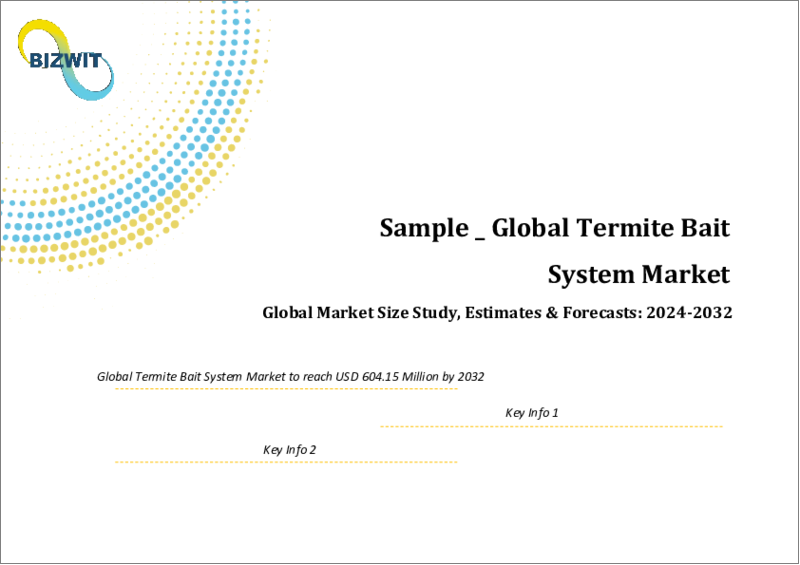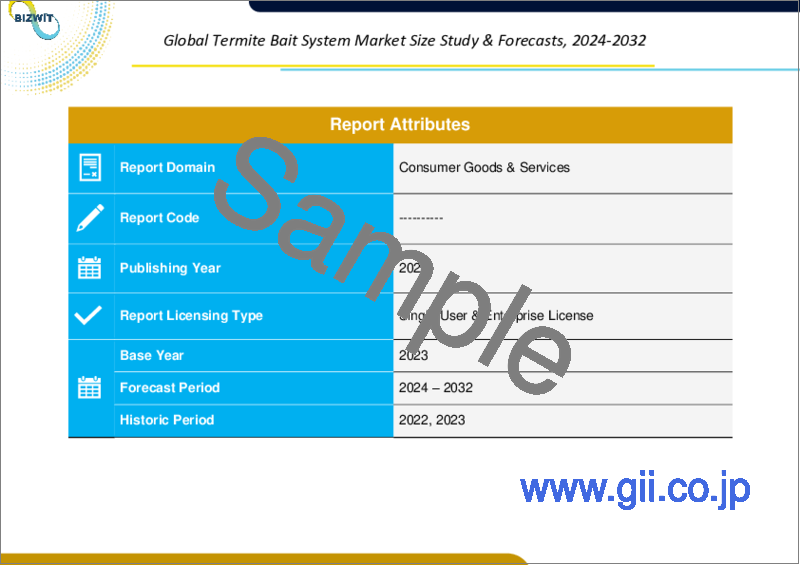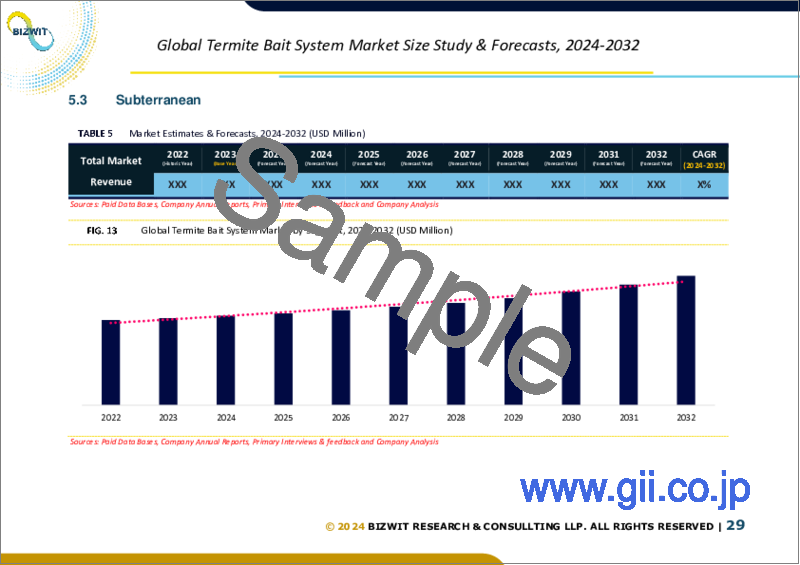|
|
市場調査レポート
商品コード
1520636
シロアリベイトシステムの世界市場規模調査:シロアリタイプ別、ステーションタイプ別、用途別、地域別予測、2022年~2032年Global Termite Bait System Market Size Study, by Termite Type, by Station Type, by Type, by Application and Regional Forecasts 2022-2032 |
||||||
カスタマイズ可能
|
|||||||
| シロアリベイトシステムの世界市場規模調査:シロアリタイプ別、ステーションタイプ別、用途別、地域別予測、2022年~2032年 |
|
出版日: 2024年07月23日
発行: Bizwit Research & Consulting LLP
ページ情報: 英文 200 Pages
納期: 2~3営業日
|
全表示
- 概要
- 目次
世界のシロアリベイトシステム市場は、2023年に約3億5,942万米ドルと評価され、予測期間2024年から2032年にかけて5.94%以上の健全な成長率で成長すると予測されています。
シロアリベイトシステムは、シロアリのコロニーを除去するために設計された害虫駆除方法です。ベイトステーションを構造物の周囲に設置し、それぞれに遅効性殺虫剤で処理したセルロースベースの材料を入れます。シロアリはベイト剤を消費してコロニーに持ち帰り、そこでベイト剤を共有することで、女王アリを含むコロニー全体を徐々に死滅させます。シロアリベイトシステムの主な用途は、住宅、商業施設、工業施設において、シロアリの被害から構造物を守ることです。このシステムは、従来の化学バリアと比較して環境への影響が最小限であること、コロニー全体を対象とする有効性、および長期的な保護が可能であることから好まれています。継続的なシロアリ防除には、ベイトステーションの定期的なモニタリングとメンテナンスが重要です。
この市場に参入している企業は、農業用にカスタマイズされたシロアリ用ベイトシステムの研究開発に力を入れています。これらのシステムには、農業環境におけるシロアリの課題に対処するために設計されたベイト剤、モニタリング装置、および展開方法が含まれます。同市場は予防対策と事後対策の両方に対応しており、農作物や構造物をシロアリの侵入から積極的に保護し、既存のシロアリ問題に対処して被害の拡大を防ぐように設計されたソリューションを提供しています。フェンス、納屋、貯蔵施設など、農場で一般的に見られる木造構造物は、特にシロアリの被害を受けやすいです。シロアリベイトシステムは、これらの構造物へのシロアリの侵入や被害を防ぎ、農園資産の長寿命化に貢献する重要な役割を果たします。また、若いプランテーションはシロアリの被害を受けやすいため、作物の生育初期段階での予防対策が不可欠です。シロアリベイトシステムを導入することで、若い植物を保護し、最適な樹勢を確保することができます。シロアリベイトシステムは、従来の化学農薬に代わる持続可能な代替策を提供します。環境に優しい農法がますます重視される中、農家は環境への影響を最小限に抑える方法に惹かれています。シロアリベイトシステムは、シロアリの個体数を効果的に管理しながら、従来の化学治療への依存を減らす魅力的な選択肢として浮上しています。
シロアリベイトシステムの世界市場調査において考慮した主な地域は、アジア太平洋地域、北米、欧州、中南米、その他ラテンアメリカ地域です。北米は、シロアリベイトシステム市場において収益面で支配的な地域です。北米のシロアリベイトシステム市場の成長を促進する主な要因には、環境に優しい害虫駆除方法に対する意識の高まり、化学農薬に対する厳しい規制、シロアリ侵入リスクを高める建設活動の増加、ベイト技術の進歩、長期的なシロアリ管理ソリューションに対する嗜好の高まりなどがあります。これらの要因が総合的に市場の需要と普及を促進しています。一方、アジア太平洋地域の市場は、予測期間2024年から2032年にかけて最も速い速度で成長すると予測されています。
目次
第1章 シロアリベイトシステムの世界市場エグゼクティブサマリー
- シロアリベイトシステムの世界市場規模・予測(2022-2032年)
- 地域別概要
- セグメント別概要
- シロアリタイプ別
- ステーションタイプ別
- タイプ別
- 用途別
- 主要動向
- 不況の影響
- アナリストの結論・提言
第2章 シロアリベイトシステムの世界市場定義と調査前提条件
- 調査目的
- 市場の定義
- 調査前提条件
- 包含と除外
- 制限事項
- 供給サイドの分析
- 入手可能性
- インフラ
- 規制環境
- 市場競争
- 経済性(消費者の視点)
- 需要サイド分析
- 規制の枠組み
- 技術の進歩
- 環境への配慮
- 消費者の意識と受容
- 調査手法
- 調査対象年
- 通貨換算レート
第3章 シロアリベイトシステムの世界市場力学
- 市場促進要因
- 農作業における木造構造物の保全の高まり
- 若いプランテーションに対する予防対策の高まり
- 化学農薬への依存度低減ニーズの高まり
- 市場の課題
- 代替技術との競合
- 研究開発コスト
- 市場機会
- シロアリの事前防除に対する需要の高まり
- ベイト装置と液体駆除法の進歩
- 新興市場での拡大
第4章 世界のシロアリベイトシステム市場産業分析
- ポーターのファイブフォースモデル
- 供給企業の交渉力
- 買い手の交渉力
- 新規参入業者の脅威
- 代替品の脅威
- 競争企業間の敵対関係
- ポーターのファイブフォースモデルへの未来的アプローチ
- ポーターのファイブフォースの影響分析
- PESTEL分析
- 政治
- 経済
- 社会
- 技術
- 環境
- 法律
- 主な投資機会
- 主要成功戦略
- 破壊的動向
- 業界専門家の視点
- アナリストの結論・提言
第5章 シロアリベイトシステムの世界市場規模と予測:シロアリタイプ別、2022年~2032年
- セグメントダッシュボード
- シロアリベイトシステムの世界市場:収益動向分析、2022年・2032年
- 地中
- 湿材
- 乾材
第6章 シロアリベイトシステムの世界市場規模と予測:ステーションタイプ別、2022年~2032年
- セグメントダッシュボード
- シロアリベイトシステムの世界市場:収益動向分析、2022年・2032年
- 地中型
- 地上型
第7章 シロアリベイトシステムの世界市場規模と予測:タイプ別、2022年~2032年
- セグメントダッシュボード
- シロアリベイトシステムの世界市場:収益動向分析、2022年・2032年
- ベイト装置
- 液体駆除方法
第8章 シロアリベイトシステムの世界市場規模と予測:用途別、2022年~2032年
- セグメントダッシュボード
- シロアリベイトシステムの世界市場:収益動向分析、2022年・2032年
- 商業産業
- 住宅
- 農業畜産農場
第9章 シロアリベイトシステムの世界市場規模と予測:地域別、2022年~2032年
- 北米
- 米国
- カナダ
- 欧州
- 英国
- ドイツ
- フランス
- スペイン
- イタリア
- その他欧州
- アジア太平洋
- 中国
- インド
- 日本
- オーストラリア
- 韓国
- その他アジア太平洋
- ラテンアメリカ
- ブラジル
- メキシコ
- その他ラテンアメリカ
- 中東・アフリカ
- サウジアラビア
- 南アフリカ
- その他中東・アフリカ
第10章 競合情報
- 主要企業のSWOT分析
- 主要市場戦略
- 企業プロファイル
- Syngenta AG
- 主要情報
- 概要
- 財務(データの入手可能性によります)
- 製品概要
- 市場戦略
- Sumitomo Chemical Co., Ltd.
- Spectrum Brands Holdings, Inc.
- Rollins, Inc.
- Arrow Exterminators, Inc.
- BASF SE
- Bayer AG
- DuPont Inc.
- Ensystex Inc.
- PCT International, Inc.
- Syngenta AG
第11章 調査プロセス
- 調査プロセス
- データマイニング
- 分析
- 市場推定
- 検証
- 出版
- 調査属性
The Global Termite Bait System Market is valued at approximately USD 359.42 million in 2023 and is anticipated to grow with a healthy growth rate of more than 5.94% over the forecast period 2024-2032. A Termite Bait System is a pest control method designed to eliminate termite colonies. It involves placing bait stations around the perimeter of a structure, each containing a cellulose-based material treated with a slow-acting insecticide. Termites consume the bait and carry it back to their colony, where it is shared, gradually killing the entire colony, including the queen. The primary application of Termite Bait Systems is in residential, commercial, and industrial settings to protect structures from termite damage. This system is favoured for its minimal environmental impact compared to traditional chemical barriers, its effectiveness in targeting entire colonies, and its ability to provide long-term protection. Regular monitoring and maintenance of bait stations are crucial for ongoing termite control.
Companies operating in this market focus heavily on research and development to create termite bait systems customized for agricultural use. These systems encompass bait formulations, monitoring devices, and deployment methods engineered to address termite challenges in farming environments. The market caters to both preventive and reactive measures, offering solutions designed to proactively protect crops and structures from termite infestations and address existing termite problems to prevent further damage. Wooden structures commonly found on farms, such as fences, barns, and storage facilities, are particularly susceptible to termite damage. Termite bait systems play a crucial role in preventing termites from infesting and damaging these structures, contributing to the longevity of farm assets. Additionally, young plantations are vulnerable to termite attacks, making preventive measures essential during the early stages of crop growth. Termite bait systems can be deployed to protect young plants and ensure their optimal establishment. Termite bait systems offer a sustainable alternative to traditional chemical pesticides. With an increasing emphasis on environmentally friendly farming practices, farmers are drawn to methods that minimize environmental impact. Termite bait systems emerge as an appealing option, reducing reliance on conventional chemical treatments while effectively managing termite populations.
The key regions considered for the Global Termite Bait System Market study include Asia Pacific, North America, Europe, Latin America, and Rest of the World. North America is a dominating region in the Termite Bait System Market in terms of revenue. The key factors driving the growth of the Termite Bait System Market in North America include increasing awareness of eco-friendly pest control methods, stringent regulations against chemical pesticides, rising construction activities boosting termite infestation risks, advancements in bait technology, and a growing preference for long-term termite management solutions. These factors collectively enhance market demand and adoption. Whereas, the market in Asia Pacific is anticipated to grow at the fastest rate over the forecast period 2024-2032.
Major market players included in this report are:
- Syngenta AG
- Sumitomo Chemical Co., Ltd.
- Spectrum Brands Holdings, Inc.
- Rollins, Inc.
- Arrow Exterminators, Inc.
- BASF SE
- Bayer AG
- DuPont Inc.
- Ensystex Inc.
- PCT International, Inc.
The detailed segments and sub-segment of the market are explained below:
By Termite Type:
- Subterranean
- Dampwood
- Drywood
By Station Type:
- In-Ground
- Above-Ground
By Type:
- Bait Devices
- Liquid Eradication Methods
By Application:
- Commercial Industrial
- Residential
- Agriculture Livestock Farms
By Region:
- North America
- U.S.
- Canada
- Europe
- UK
- Germany
- France
- Spain
- Italy
- ROE
- Asia Pacific
- China
- India
- Japan
- Australia
- South Korea
- RoAPAC
- Latin America
- Brazil
- Mexico
- Middle East & Africa
- Saudi Arabia
- South Africa
- RoMEA
Years considered for the study are as follows:
- Historical year - 2022
- Base year - 2023
- Forecast period - 2024 to 2032
Key Takeaways:
- Market Estimates & Forecast for 10 years from 2022 to 2032.
- Annualized revenues and regional level analysis for each market segment.
- Detailed analysis of geographical landscape with Country level analysis of major regions.
- Competitive landscape with information on major players in the market.
- Analysis of key business strategies and recommendations on future market approach.
- Analysis of competitive structure of the market.
- Demand side and supply side analysis of the market.
Table of Contents
Chapter 1. Global Termite Bait System Market Executive Summary
- 1.1. Global Termite Bait System Market Size & Forecast (2022-2032)
- 1.2. Regional Summary
- 1.3. Segmental Summary
- 1.3.1. By Termite Type
- 1.3.2. By Station Type
- 1.3.3. By Type
- 1.3.4. By Application
- 1.4. Key Trends
- 1.5. Recession Impact
- 1.6. Analyst Recommendation & Conclusion
Chapter 2. Global Termite Bait System Market Definition and Research Assumptions
- 2.1. Research Objective
- 2.2. Market Definition
- 2.3. Research Assumptions
- 2.3.1. Inclusion & Exclusion
- 2.3.2. Limitations
- 2.3.3. Supply Side Analysis
- 2.3.3.1. Availability
- 2.3.3.2. Infrastructure
- 2.3.3.3. Regulatory Environment
- 2.3.3.4. Market Competition
- 2.3.3.5. Economic Viability (Consumer's Perspective)
- 2.3.4. Demand Side Analysis
- 2.3.4.1. Regulatory Frameworks
- 2.3.4.2. Technological Advancements
- 2.3.4.3. Environmental Considerations
- 2.3.4.4. Consumer Awareness & Acceptance
- 2.4. Estimation Methodology
- 2.5. Years Considered for the Study
- 2.6. Currency Conversion Rates
Chapter 3. Global Termite Bait System Market Dynamics
- 3.1. Market Drivers
- 3.1.1. Growing Preservation of Wooden Structures in Farming Operations
- 3.1.2. Rising Preventive Measures for Young Plantations
- 3.1.3. Increasing Need of Reduced Reliance on Chemical Pesticides
- 3.2. Market Challenges
- 3.2.1. Competition from Alternative Technologies
- 3.2.2. Cost of Research and Development
- 3.3. Market Opportunities
- 3.3.1. Rising Demand for Pre-Termite Control
- 3.3.2. Advancements in Bait Devices and Liquid Eradication Methods
- 3.3.3. Expansion in Emerging Markets
Chapter 4. Global Termite Bait System Market Industry Analysis
- 4.1. Porter's 5 Force Model
- 4.1.1. Bargaining Power of Suppliers
- 4.1.2. Bargaining Power of Buyers
- 4.1.3. Threat of New Entrants
- 4.1.4. Threat of Substitutes
- 4.1.5. Competitive Rivalry
- 4.1.6. Futuristic Approach to Porter's 5 Force Model
- 4.1.7. Porter's 5 Force Impact Analysis
- 4.2. PESTEL Analysis
- 4.2.1. Political
- 4.2.2. Economical
- 4.2.3. Social
- 4.2.4. Technological
- 4.2.5. Environmental
- 4.2.6. Legal
- 4.3. Top Investment Opportunity
- 4.4. Top Winning Strategies
- 4.5. Disruptive Trends
- 4.6. Industry Expert Perspective
- 4.7. Analyst Recommendation & Conclusion
Chapter 5. Global Termite Bait System Market Size & Forecasts by Termite Type 2022-2032
- 5.1. Segment Dashboard
- 5.2. Global Termite Bait System Market: Termite Type Revenue Trend Analysis, 2022 & 2032 (USD Million)
- 5.2.1. Subterranean
- 5.2.2. Dampwood
- 5.2.3. Drywood
Chapter 6. Global Termite Bait System Market Size & Forecasts by Station Type 2022-2032
- 6.1. Segment Dashboard
- 6.2. Global Termite Bait System Market: Station Type Revenue Trend Analysis, 2022 & 2032 (USD Million)
- 6.2.1. In-Ground
- 6.2.2. Above-Ground
Chapter 7. Global Termite Bait System Market Size & Forecasts by Type 2022-2032
- 7.1. Segment Dashboard
- 7.2. Global Termite Bait System Market: Type Revenue Trend Analysis, 2022 & 2032 (USD Million)
- 7.2.1. Bait Devices
- 7.2.2. Liquid Eradication Methods
Chapter 8. Global Termite Bait System Market Size & Forecasts by Application 2022-2032
- 8.1. Segment Dashboard
- 8.2. Global Termite Bait System Market: Application Revenue Trend Analysis, 2022 & 2032 (USD Million)
- 8.2.1. Commercial Industrial
- 8.2.2. Residential
- 8.2.3. Agriculture Livestock Farms
Chapter 9. Global Termite Bait System Market Size & Forecasts by Region 2022-2032
- 9.1. North America Termite Bait System Market
- 9.1.1. U.S. Termite Bait System Market
- 9.1.1.1. Termite Type breakdown size & forecasts, 2022-2032
- 9.1.1.2. Station Type breakdown size & forecasts, 2022-2032
- 9.1.1.3. Type breakdown size & forecasts, 2022-2032
- 9.1.1.4. Application breakdown size & forecasts, 2022-2032
- 9.1.2. Canada Termite Bait System Market
- 9.1.1. U.S. Termite Bait System Market
- 9.2. Europe Termite Bait System Market
- 9.2.1. U.K. Termite Bait System Market
- 9.2.2. Germany Termite Bait System Market
- 9.2.3. France Termite Bait System Market
- 9.2.4. Spain Termite Bait System Market
- 9.2.5. Italy Termite Bait System Market
- 9.2.6. Rest of Europe Termite Bait System Market
- 9.3. Asia-Pacific Termite Bait System Market
- 9.3.1. China Termite Bait System Market
- 9.3.2. India Termite Bait System Market
- 9.3.3. Japan Termite Bait System Market
- 9.3.4. Australia Termite Bait System Market
- 9.3.5. South Korea Termite Bait System Market
- 9.3.6. Rest of Asia Pacific Termite Bait System Market
- 9.4. Latin America Termite Bait System Market
- 9.4.1. Brazil Termite Bait System Market
- 9.4.2. Mexico Termite Bait System Market
- 9.4.3. Rest of Latin America Termite Bait System Market
- 9.5. Middle East & Africa Termite Bait System Market
- 9.5.1. Saudi Arabia Termite Bait System Market
- 9.5.2. South Africa Termite Bait System Market
- 9.5.3. Rest of Middle East & Africa Termite Bait System Market
Chapter 10. Competitive Intelligence
- 10.1. Key Company SWOT Analysis
- 10.2. Top Market Strategies
- 10.3. Company Profiles
- 10.3.1. Syngenta AG
- 10.3.1.1. Key Information
- 10.3.1.2. Overview
- 10.3.1.3. Financial (Subject to Data Availability)
- 10.3.1.4. Product Summary
- 10.3.1.5. Market Strategies
- 10.3.2. Sumitomo Chemical Co., Ltd.
- 10.3.3. Spectrum Brands Holdings, Inc.
- 10.3.4. Rollins, Inc.
- 10.3.5. Arrow Exterminators, Inc.
- 10.3.6. BASF SE
- 10.3.7. Bayer AG
- 10.3.8. DuPont Inc.
- 10.3.9. Ensystex Inc.
- 10.3.10. PCT International, Inc.
- 10.3.1. Syngenta AG
Chapter 11. Research Process
- 11.1. Research Process
- 11.1.1. Data Mining
- 11.1.2. Analysis
- 11.1.3. Market Estimation
- 11.1.4. Validation
- 11.1.5. Publishing
- 11.2. Research Attributes






